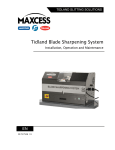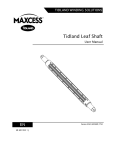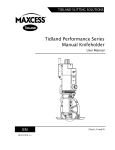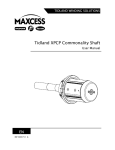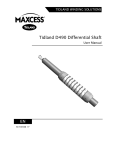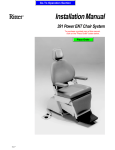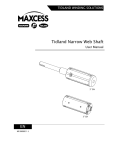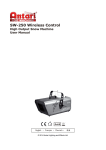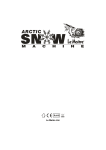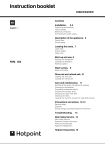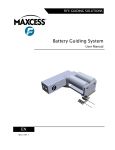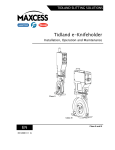Download Model D4 Differential Shaft User Manual: Tidland
Transcript
TIDLAND WINDING SOLUTIONS Tidland D4 Differential Air Shaft Installation, Operation and Maintenance EN MI 638672 1 Q TABLE OF CONTENTS Important Safety Instructions................................................................................................................... 3 Caution .................................................................................................................................................... 3 Tidland Customer Service ....................................................................................................................... 4 Recommended tools................................................................................................................................ 4 Maintenance Schedule ............................................................................................................................ 4 Overview.................................................................................................................................................. 5 Cartridge Assemblies .......................................................................................................................... 5 With Springs.................................................................................................................................... 5 Without Springs............................................................................................................................... 5 Dimensional & Quality Recommendations for Cores.......................................................................... 6 Core Dimensions ............................................................................................................................ 6 General Core Quality ...................................................................................................................... 6 Core Installation .............................................................................................................................. 6 Operation ................................................................................................................................................. 7 Pressure Control Valve System .......................................................................................................... 7 Cores: Installing and Removing ......................................................................................................... 8 Winding ............................................................................................................................................... 8 Bleeder Valves .................................................................................................................................... 9 Muffler ............................................................................................................................................. 9 Adjusting the Exhaust Bleeder Valve.............................................................................................. 9 Maintenance .......................................................................................................................................... 10 Exhaust Bleeder Valve...................................................................................................................... 10 Cleaning........................................................................................................................................ 10 Replacing ...................................................................................................................................... 10 To Disassemble the Shaft ................................................................................................................. 11 Collar and Cartridges.................................................................................................................... 11 Felt Strip and Bladder ................................................................................................................... 12 Removing ................................................................................................................................. 12 Replacing.................................................................................................................................. 12 Cartridges.......................................................................................................................................... 14 Without Springs............................................................................................................................. 14 Disassembly ............................................................................................................................. 14 Assembly .................................................................................................................................. 14 Reinstalling or Reversing Cartridges........................................................................................ 15 With Springs.................................................................................................................................. 16 Disassembly ............................................................................................................................. 16 Assembly .................................................................................................................................. 16 Reinstalling or Reversing Cartridges........................................................................................ 17 Assembly Diagram and Parts List ......................................................................................................... 18 Troubleshooting..................................................................................................................................... 19 Shaft .................................................................................................................................................. 19 Air Leaks ........................................................................................................................................... 20 Tidland Differential D4 – Installation, Operation and Maintenance 2 08/11 www.maxcessintl.com 360.834.2345 IMPORTANT SAFETY INSTRUCTIONS When using this Tidland product, follow basic safety to reduce the risk of personal injury. Your company's safety instructions and procedures should always be followed. When using this product with any other equipment or machinery, all safety requirements stipulated by that equipment or machinery manufacturer must be followed. Compliance with local, state, and federal safety requirements is your responsibility. No part of these or the following instructions should be construed as conflicting with or nullifying the instructions from other sources. Be familiar with the hazards and safety requirements in your work environment and always work safely. 1. 2. 3. 4. 5. 6. 7. 8. 9. 10. 11. 12. 13. 14. 15. 16. 17. Read and understand all instructions and shaft design application limits before operation. Never use this product for a purpose or in a machine that it was not specifically designed for. See Product Safety Data Sheet (PSDS). Do not exceed the operation loads for this shaft as noted on its PSDS. Follow all warnings and instructions marked on the product and on the PSDS. Inspect the shaft for wear and/or other safety and functional deficiencies daily, before each use. Wear safety glasses or proper eye protection when inflating or deflating or otherwise operating the air system. Do not remove or otherwise alter any setscrews or fastening devices prior to using this product. Do not operate this product if any setscrews or fastening devices are missing. Do not lift shaft manually if it is beyond your capacity. Loads over 1/3 your body weight may be prohibitive. Consult your company safety policy. When lifting a shaft, use proper lifting techniques, keeping back straight and lifting with the legs. Do not carry or lift this product over wet or slippery surfaces. Use appropriate mechanical lifting devices for heavier shafts such as a hoist or shaft puller. Use lifting devices only as designed for this product. When performing maintenance or repair procedures, do not pressurize the shaft if journal setscrews are loose or missing. When performing maintenance procedures, do not pressurize the shaft if the journal is missing. All replacement parts used on this product should be made to original Tidland specifications. All maintenance and repair procedures performed on this product should be done to Tidland specifications by qualified personnel. CAUTION • • Wear eye protection when using tools or compressed air. The cartridges are directional and are factory installed relative to customer shaft rotation direction. Cartridges installed incorrectly will not grip the cores. See page 5. • When ordering 3"-6" cartridge adapters, be sure to confirm your application and load requirements with Tidland Customer Service. Use hoist to lift or move the 6" D4 shaft. Tidland Differential D4 – Installation, Operation and Maintenance 3 08/11 www.maxcessintl.com 360.834.2345 TIDLAND CUSTOMER SERVICE 800.426.1000 (360.834.2345) www.maxcessintl.com Visit the Tidland Repair and Return Center online to review our return policies or to submit an electronic Return Material Authorization Request at www.maxcessintl.com/returns. RECOMMENDED TOOLS • • • • • • Dow Corning Molykote® 557 Silicone Dry Film Lubricant (or non-petroleum equivalent) Hex drive wrenches: 1/8", 3/16", 3mm Tidland Hole Punch Guide (P/N 647597) Tidland Hole Punch (P/N 560345) Small flathead screwdriver LOCTITE® 242 (blue) NOTICE When using Dow Corning 557 Dry Film Lubricant: • Apply a very thin film to the shaft body. • Do not allow the lubricant to pool in bladder slot or shaft recesses. • Allow the lubricant to dry for 30 minutes. • Wipe the shaft body down with a clean cloth. For more accessories to help with your winding processes, visit www.maxcessintl.com. MAINTENANCE SCHEDULE Every 30 Days • • • Deflate shaft completely and remove cores. Use compressed air to blow out dust and ensure that cartridges turn freely on the shaft. If cartridges are sticking, follow the instructions on page 11 to disassemble the shaft. • Inspect felt for wear. Replace discolored or compressed, deformed material (page 12). • Inspect shaft body for wear. There should be no signs of galling; if scoring or serious wear is detected, call Tidland Customer Service for assistance. • Inspect cartridges for wear and debris buildup. Disassemble cartridges and clean thoroughly. • Before reinstalling cartridges: a) Apply a very thin film of Dow Corning 557 Silicone Dry Film Lubricant to the shaft body. Do not allow the lubricant to pool in bladder slot or shaft recesses. b) Allow the lubricant to dry for 30 minutes. c) Wipe the shaft body down with a clean cloth. Every 6 Months • Disassemble, clean and lubricate the shaft (page 11). Tidland Differential D4 – Installation, Operation and Maintenance 4 08/11 www.maxcessintl.com 360.834.2345 OVERVIEW Cartridge Assemblies The cartridge on the D4 Differential shaft is designed to spin on the shaft even after web tension causes it to grip and lock the core. Slippage is between the shaft body and the cartridge, not the core, so dust is not generated by core wear. Independent cartridges allow for winding multiple cores of different roll widths and roll diameters at the same tension. The Tidland D4 differential shaft is designed for rewind applications. If you would like to use a D4 for an unwind operation, please contact Tidland Customer Service at 1-800-426-1000. Important! • • • • The cartridges are directional and are factory installed relative to customer shaft rotation direction. Determine shaft rotation, clockwise or counterclockwise, looking toward the machine end of the shaft. If the shaft is reinstalled on another machine and rotation direction changes, the cartridges must be removed, reversed and reinstalled. Use the images below to help determine which cartridge your shaft uses. Refer to shaft assembly details for proper installation. Cartridges installed incorrectly will not grip the cores. With Springs Newer shafts feature an updated cartridge design with one or two springs that help the steel balls engage with the cores as they are being loaded onto the shaft, allowing immediate core-locking action as soon as the winding operation begins. The cartridge is held together with two retainer snap rings. If your cartridge is assembled with springs, you will notice a distinctive wave-like pattern around the face of the cartridge. This feature will help you orient the cartridges in the correct direction on the shaft. See page 17 for shaft assembly details. Cartridges engraved with an arrow indicate the direction in which cartridge should be installed. Arrow should point in the direction of shaft rotation. Without Springs Cartridges without springs have only one retainer ring, which faces toward or away from the machine end of the shaft depending on shaft rotation direction. See page 15 for assembly details. The figure to the right represents a view of the retainer ring. Cartridge type is easy to identify by removing the collar at the operator end of the shaft. Tidland Differential D4 – Installation, Operation and Maintenance 5 08/11 www.maxcessintl.com 360.834.2345 OVERVIEW Dimensional & Quality Recommendations for Cores (for use with D4 Differential Winding) Core Dimensions 1. Core ID Range must be between 3" Shafts: 3.005" – 3.040" 6" Shafts: 6.005" – 6.060" a) If Core I.D.s are smaller they will be very difficult to load onto shaft. If larger, they will not lock up properly. b) Long cores (large slit widths) and cores with I.D. defects (for example, ovality, curvature, etc.) will be more difficult to load if they are at the low end of allowable range. 2. Core width must be greater than 3" Shafts: 0.875" when using narrow (0.75") cartridges 2.00" when using wide (1.25") cartridges 6" Shafts: 2.00" when using 1.50" cartridges 3. Core width runout on a single core should be no greater than 0.020" 4. Core wall thickness tolerance on a single core should be no greater than 0.010". Variance in the core wall thickness will contribute to increased vibration and reduced roll quality. General Core Quality • • Surface condition of the Internal Diameter should be smooth for easy installation. Inner edges of cores should be clean and without rough burrs. Core Installation • During both installation and removal a slight twist, against the spring, helps make it easier to slide the cores on and off. Tidland Differential D4 – Installation, Operation and Maintenance 6 08/11 www.maxcessintl.com 360.834.2345 OPERATION NOTICE Before beginning the winding operation, please read and understand the following. Pressure Control Valve System Successful operation of the Tidland Differential Shaft series depends upon proper internal air pressure. Each of the Differential Shaft models can be equipped with a pressure control system comprising two bleeder valves. Used with your applied air pressure, these valves allow the operator to adjust and maintain internal air pressure, which is critical in low-tension winding applications where the required internal pressure is very low and the pressure range is very small. Variable pressure is required in order to control the air pressure on the tension segments as the roll diameter increases. As the roll diameter grows, the required rate of pressure increase will diminish due to the weight of the roll and friction between the roll and shaft. These parameters will vary based on your application. How It Works As operating air pressure is applied to the shaft, the factory-set inlet valve causes a drop in pressure as air enters the bladder. The exhaust bleeder valve controls the amount of that pressure drop. The larger the exhaust opening, the greater the pressure drop, resulting in lower internal bladder pressure. Reducing the exhaust opening increases the internal air pressure. If you are unable to achieve optimal tension control by adjusting your applied air pressure, use the exhaust bleeder valve to improve the resolution of your tension controller. CAUSES A PRESSURE DROP; SHOULD NOT REQUIRE ADJUSTMENT AFFECTS THE INTERNAL AIR PRESSURE; CONTROL THE PRESSURE DROP BY ADJUSTING THE OUTLET (EXHAUST BLEEDER VALVE, PAGE 8) Tidland Differential D4 – Installation, Operation and Maintenance 7 08/11 www.maxcessintl.com 360.834.2345 OPERATION Cores: Installing and Removing Refer to page 6 for core dimension and quality recommendations. 1. Inflate the shaft to lock the inner race of the cartridges to the shaft (45 psi max). 2. Install the cores, twisting them in the direction of the arrow (engraved on the cartridge outer race). This will help the cores slide onto the shaft more easily. 3. Adjust core positions and attach the web. 4. Resume normal pressure control once winding starts. To remove the cores, inflate the shaft to maximum pressure and twist the cores in the direction of the arrow while sliding them off of the shaft. NOTICE For maximum operating air pressure, refer to the chart below. Winding The Tidland D4 differential shaft is designed for rewind applications. If you would like to use a D4 for an unwind operation, please contact Tidland Customer Service at 1-800-426-1000. 1. Begin the winding operation at 0-5 psi for low-tension winding. 2. During winding, observe the tension controller readout and adjust the applied air pressure as needed. Adjusting the exhaust bleeder valve may improve the effectiveness of the tension controller. (See page 9.) D4 Pressure/Overspeed Limits (Maintaining Safe Temperature for Plastic Components - 70° Ambient) 310 290 270 OVERSPEED, rpm 250 Overheating or seizing will occur 230 210 190 170 150 130 Recommended operation 110 90 5 10 15 20 25 30 35 40 45 PRESSURE, psi Tidland Differential D4 – Installation, Operation and Maintenance 8 08/11 www.maxcessintl.com 360.834.2345 OPERATION Bleeder Valves As operating air pressure is applied to the shaft, the factory-set inlet valve causes a drop in pressure as air enters the bladder. The exhaust bleeder valve controls the amount of that pressure drop. The larger the exhaust opening, the greater the pressure drop, resulting in lower internal bladder pressure. Reducing the exhaust opening increases the internal air pressure. • • • • • Both valves are factory-set according to customer operating specifications: roll specs (width, diameter and weight), and web tension (PLI). If you are unable to achieve optimal tension control by adjusting your applied air pressure, use the exhaust bleeder valve to improve the resolution of your tension controller. For the majority of applications, no adjustment is required for the exhaust bleeder valve. For higher internal pressure, adjust to a smaller opening in the valve. For lower internal pressure, adjust to a larger opening. Adjustments are made with a 1/8" hex key. The restrictor valve at the inlet should not require adjustment. Do not operate shaft with missing valves. A muffler may be installed* on the exhaust bleeder valve outlet to reduce noise. A slight hiss may be audible: this indicates that the Pressure Control Valve System is functioning, allowing air to escape from the shaft as designed. The muffler must be removed (12 mm socket) before attempting to adjust or remove the bleeder valve. (See Replacing the Bleeder Valves, page 10.) *Not available on all Differential shaft designs. • The purpose of this graph is to illustrate the characteristics of bleeder valve function. The tension values displayed are arbitrary. Exhaust Bleeder Valve Function 0.60 VALVE CLOSED • Actual winding tension will differ by variables such as bladder length, shaft speed, roll specs (width, diameter and weight), and core material. WEB TENSION - PLI 0.50 1/8 TURN OPEN 0.40 0.30 0.20 1/4 TURN OPEN 0.10 0.00 0.0 5.0 10.0 15.0 20.0 25.0 30.0 35.0 40.0 APPLIED AIR PRESSURE - PSI Adjusting the Exhaust Bleeder Valve 1. Stop winding operation and shaft rotation. 2. To adjust the internal air pressure, turn the valve in 1/8 turn increments using a 1/8" hex drive wrench. • To increase the pressure, turn the valve clockwise. • To decrease the pressure, turn the valve counterclockwise. CLOSE DO NOT adjust while shaft is spinning. To clean or replace the valve, see page 10. Tidland Differential D4 – Installation, Operation and Maintenance 9 08/11 www.maxcessintl.com 360.834.2345 MAINTENANCE Maintaining the Bleeder Valve If maintaining low tension during winding becomes difficult, the bleeder valve may require adjustment or cleaning. Note: • The fine threads on the needle and the housing are easy to damage. Use care when working with these components. • Do not attempt to remove the bleeder valve housing from the shaft. If repair is necessary, return the shaft to Tidland. (www.maxcessintl.com/returns) • Location of valve varies due to custom shaft configurations. Do not operate the shaft if: the valve is missing. the orifice is otherwise plugged. • • Cleaning the Exhaust Bleeder Valve 1. 2. 3. 4. 5. 6. 7. 8. 9. Stop the winding operation and shaft rotation. Locate the bleeder valve at the end or on the side of the shaft. Using a 12 mm socket, carefully remove muffler*, if installed. Using a 1/8" hex drive, carefully back the needle valve all the way out of its housing (counterclockwise). Using compressed air, blow dust and debris out of the valve. Carefully reinstall the needle valve in the housing. Close the valve down until it just bottoms out in the housing, and then adjust as required for your application. Resume winding operation. Adjust the bleeder valve incrementally to achieve required internal pressure. VALVE MUFFLER *Not available on all Differential shaft designs. Replacing the Exhaust Bleeder Valve 1. 2. 3. 4. 5. 6. Stop the winding operation and shaft rotation. Locate the bleeder valve at the end or on the side of the shaft. Using a 12 mm socket, carefully remove muffler, if installed. Using a 1/8" hex drive, carefully back the needle all the way out of its housing (counterclockwise). Carefully reinstall the needle valve in the housing. Close the valve down until it just bottoms out in the housing, and then adjust as required for your application. 7. Resume winding operation. 8. Adjust the bleeder valve incrementally to achieve required internal pressure. Tidland Differential D4 – Installation, Operation and Maintenance 10 08/11 www.maxcessintl.com 360.834.2345 MAINTENANCE To Disassemble the Shaft Removing Collar and Cartridges Pay close attention to the orientation of the cartridges and washers when removing components from the shaft body. Proper reinstallation depends on shaft rotation. 1. Loosen – do not remove – the setscrews (3/16" hex drive) holding the collar at the journal end of the shaft body. Note: On cantilevered shafts with nose cones, remove the nose cone. Use a 3 mm hex drive wrench to remove the three setscrews. The collar has no setscrews. 3. Remove the collar. 4. Remove the thrust washer, if installed. 5. Remove the cartridges, washers and remaining thrust washer. Note: Do not remove the collar at the machine end except to replace the felt strips or bladder. 6. To remove bladder, see page 12. 7. Inspect felt for wear. Replace discolored or compressed, deformed material. 8. Inspect shaft body for wear. There should be no signs of galling; if scoring or serious wear is detected, call Tidland Customer Service for assistance. 9. Inspect cartridges for wear and debris buildup. Disassemble and clean if necessary: without springs – page 14 with springs – page 16 To reinstall or reverse cartridges, see page 15 (without springs) or page 17 (with springs). COLLAR (MACHINE END) JOURNAL CONFIGURATION SHAFT BODY *THRUST WASHER CARTRIDGES WASHER *THRUST WASHER COLLAR SETSCREW SHAFT BODY * Thrust washer not used on shafts with spring-loaded cartridges. NOSE CONE NOSE CONE CONFIGURATION CAPSCREW (3 PLCS) Tidland Differential D4 – Installation, Operation and Maintenance 11 08/11 www.maxcessintl.com 360.834.2345 MAINTENANCE Removing Felt Strip and Bladder 1. Follow instructions for shaft disassembly on page 11. 2. Using 3/16" hex drive wrench, remove screws from end clamps and remove the clamps from each end of the shaft. 3. Remove the felt strip. 4. Pull the air fittings from their locations in the slot and remove the bladder from the slot carefully so as not to damage the air fittings. 5. Remove the air fittings from the bladder. 6. Inspect the bladder and replace if necessary. SCREWS END CLAMP FELT AIR FITTING BLADDER SHAFT Tidland recommends replacing the bladder and felt strip components at the same time. Replacing Felt Strip and Bladder Tidland recommends replacing both components at the same time. 1. Follow the instructions for shaft disassembly on page 11. 2. Remove both of the air fittings from the old bladder and set aside. 3. Clean the slot with a soft cloth. A rag damp with mild solvent, such as rubbing alcohol, is acceptable. Caution: • Make sure all parts are completely dry before reassembling the shaft. Bladder and felt strip material supplied for replacement will be longer than the required finished length. Do not cut to length until instructed in Steps 0 and 0. Fig. 4 HOLE PUNCH TOOL .460" BLADDER BLADDER AIR FITTING HOLE PUNCH GUIDE 4. Cut one end of the bladder square. (Bladders cut at any angle are at risk for leakage.) 5. Insert the Tidland Hole Punch Guide into the bladder and with the Tidland Hole Punch Tool, punch a hole in one wall only of the bladder (Fig. 4). 6. Insert air fitting into the bladder (Fig. 5). Tidland Differential D4 – Installation, Operation and Maintenance 12 08/11 www.maxcessintl.com 360.834.2345 MAINTENANCE Replacing Felt Strip and Bladder (continued) 7. Lay the bladder in the slot and insert the air fitting into the shaft. 8. Lay the new felt strip on top of the bladder as shown in Fig. 6. 9. Apply a small amount of Loctite 242 to the end clamp screw threads and secure both components with one end clamp. Note: Only the bladder end is pinched under the ridge on the underside of the clamp. The felt strip is secured by the end clamp as shown in Fig. 6. Using 3mm hex drive wrench, tighten end clamp screws to 9-10 in·lbs. END CLAMP FELT STRIP FELT END CLAMP BLADDER AIR FITTING 10. To cut the bladder to the required length, install it along the length of the slot. Do not stretch the bladder. 11. Mark the bladder at a point 0.140" from the end clamp screw hole centers (Fig. 7). Lift the bladder out of the slot and cut square across its end. 0.140" SLOT BLADDER SCREW HOLE 0.30" FELT STRIP 12. Using the Tidland Hole Punch Guide and Tool, punch a hole in one wall of the bladder. 13. Insert the remaining air fitting into the bladder. 14. Reinstall the bladder along the length of the slot and insert the air fitting into the shaft. Before installing felt strip: a) Apply a very thin film of Dow Corning 557 Silicone Dry Film Lubricant to the shaft body. Do not allow the lubricant to pool in the bladder slot or shaft recesses. b) Allow the lubricant to dry for 30 minutes. c) Wipe the shaft body down with a clean cloth. Make sure to wipe the slot also. d) Proceed to Step 0. 15. To cut the felt strip to the required length, install it along the length of the slot. Stretch the felt strip using 1-1.5 lbs of force and mark a point 0.30" from the end clamp screw hole centers. Lift the end of the felt strip out of the slot and cut it square across the end where marked. 16. Lay the felt strip back in the slot and stretch it until the end covers the air fitting. Secure bladder and felt strip with the remaining end clamp as shown in Fig 6. Use small amount of Loctite 242 on the screw threads. Tighten clamps to 9-10 in·lbs. 17. Push all cartridges toward the fixed end and reinstall the collar. To prevent cartridges from seizing, leave a .030-.060" gap between the last cartridge installed and the collar. Tidland Differential D4 – Installation, Operation and Maintenance 13 08/11 www.maxcessintl.com 360.834.2345 MAINTENANCE Cartridges – Without Springs Disassembly The cartridge assembly is made up of an inner race, an outer race, and twelve chrome balls held together by a retainer ring. The cartridge assembly may be disassembled for cleaning. Inspect the cartridges on the shaft once a month for wear or dust buildup. Use compressed air to blow out dust and ensure that cartridges turn freely on the shaft. If the cartridges stick, follow the instructions on page 11 to disassemble the shaft and remove the cartridges for cleaning and further inspection. 1. Place the cartridge assembly on the work RETAINER RING surface with the retainer ring facing up. 2. Align the gap in the retainer ring with any notch in the race. Using a small flathead screwdriver, carefully pry the retainer ring off OUTER RACE the cartridge. CHROME BALLS 3. Remove the first row of six chrome balls and lift off the outer race. 4. Remove the remaining six balls. INNER RACE 5. Clean all parts – mild solvents, such as rubbing alcohol, are acceptable. Replace worn cartridges. Note: • Remove all solvent with a dry cloth before reassembly so parts do not accumulate debris. • Petroleum-based solvents will destroy bladder material. ALIGN NOTCHES Assembly 1. Place the inner race on the work surface with notches facing up. 2. Slide the outer race over the inner race, aligning notches as indicated in Fig. 1. 3. Lift the outer race just enough to insert the chrome balls in the inner race notches, one at a time, in six places. Note: If notches are not aligned, the balls will not fit into place. 4. Let the outer race slide down into place to secure the first row of chrome balls. 5. Insert the rest of the chrome balls in the outer race notches (Fig. 2). 6. Reinstall the retaining ring to secure the assembly (Fig. 3). 7. Before installing the cartridges: a. Apply a very thin film of Dow Corning 557 Silicone Dry Film Lubricant to the shaft body. Avoid spraying the felt strip. b. Allow the lubricant to dry for 30 minutes. c. Wipe the shaft body down with a clean cloth. 8. Reinstall cartridges according to the diagram on page 15. Tidland Differential D4 – Installation, Operation and Maintenance 14 OUTER RACE INNER RACE RETAINER RING 08/11 www.maxcessintl.com 360.834.2345 MAINTENANCE Reinstalling or Reversing Cartridges – Without Springs Important:: • Correct installation of cartridges depends upon shaft rotation direction. • Before reinstalling cartridges: a) Apply a very thin film of Dow Corning 557 Silicone Dry Film Lubricant to the shaft body. Avoid spraying the felt strip. b) Allow the lubricant to dry for 30 minutes. c) Wipe the shaft body down with a clean cloth. • • • • Mount thrust washer with the flat side against the collar (2 places). When reinstalling collars, make sure that setscrew holes align with flats on shaft body, and that the bleeder valve hole is aligned for access during reinstallation of the valve. Make sure there is a washer in between each cartridge and/or collar. Push all cartridges to the fixed end and install the remaining collar. To prevent cartridges from seizing, leave a .030"-.060" gap between the last cartridge installed and the collar. COLLAR (MACHINE END) MACHINE END SHAFT BODY SHAFT ROTATION DIRECTION FLATS (SETSCREW) JOURNAL THRUST WASHER (FEMALE) AT ASSEMBLY: Leave .030-.060" gap between last cartridge and collar. WASHER CARTRIDGE ASSEMBLY (RETAINER RING POINTS TOWARD MACHINE END) THRUST WASHER (MALE) COLLAR (JOURNAL END) SHAFT ROTATION RETAINER RING MACHINE END SHAFT ROTATION DIRECTION THRUST WASHER AT ASSEMBLY: Leave .030-.060" gap between last cartridge and collar. CARTRIDGE ASSEMBLY (RETAINER RING POINTS AWAY FROM MACHINE END) THRUST WASHER (FEMALE) Tidland Differential D4 – Installation, Operation and Maintenance SHAFT ROTATION 08/11 RETAINER RING MAINTENANCE Cartridges – With Springs Disassembly Tip: Work over a shop rag or tray in order to contain the balls during disassembly. 1. Remove one snap ring from the cartridge to free the cartridge outer race. (It does not matter which ring is removed; it is not necessary to remove both rings.) Note: Removing the outer race will allow the balls to fall freely. 2. Remove the spring(s) from the inner race and set aside. 3. Remove dust and debris from cartridge parts and clean using a mild solvent, such as rubbing alcohol. Replace worn parts. NOTICE Spring constant (lb f /in) is calculated for successful operation of the Tidland D4 shaft. Do not replace springs with anything other than Tidland factory parts. Assembly SPRING 1. Remove all solvent with a dry cloth before reassembly to reduce accumulation of dust on cartridges and shaft. 2. There should be one snap ring installed on the inner race before beginning reassembly. 3. Install the spring(s) securely in the groove(s) provided in the cartridge inner race. 4. On a flat work surface, place the inner race inside the outer race. SNAP RING INNER RACE OUTER RACE If there is an arrow engraved on the outer race, ensure that it points in the direction of spring compression (installed in the inner race). INSERT BALLS 5. Install a row of balls in the slots next to the snap ring. COMPRESS SPRING 6. Lift up on the outer race, which helps hold the balls in place, and turn the cartridge over. 7. Install the remaining balls in the slots. Note: Spring(s) must be compressed to allow the ball(s) to fit properly in the slot(s). 8. Install the remaining snap ring. 9. Before installing the cartridges: a) Apply a very thin film of Dow Corning 557 Silicone Dry Film Lubricant to the shaft body. Avoid spraying the felt strip. b) Allow the lubricant to dry for 30 minutes. c) Wipe the shaft body down with a clean cloth. SNAP RING 10. Reinstall cartridges according to the diagram on page 17. Tidland Differential D4 – Installation, Operation and Maintenance 16 01/12 www.maxcessintl.com 360.834.2345 MAINTENANCE Reinstalling or Reversing Cartridges – With Springs Important: • Correct installation of cartridges depends upon shaft rotation direction. • Before reinstalling cartridges: a) Apply a very thin film of Dow Corning 557 Silicone Dry Film Lubricant to the shaft body. Avoid spraying the felt strip. b) Allow the lubricant to dry for 30 minutes. c) Wipe the shaft body down with a clean cloth. • • • When reinstalling collars, make sure that setscrew holes align with flats on shaft body, and that the bleeder valve hole is aligned for access during reinstallation of the valve. Make sure there is a washer in between each cartridge and/or collar. Push all cartridges to the fixed end and install the remaining collar. To prevent cartridges from seizing, leave a .030"-.060" gap between the last cartridge installed and the collar. Note "wave" direction on cartridge. If there is an arrow engraved on the outer race, it must point in the direction of shaft rotation. COLLAR SHAFT BODY FLATS SHAFT ROTATION DIRECTION AT ASSEMBLY: Leave .030-.060" gap between last cartridge and collar. WASHER CARTRIDGE WITH SPRINGS COLLAR Note "wave" direction on cartridge. If there is an arrow engraved on the outer race, it must point in the direction of shaft rotation. SHAFT ROTATION DIRECTION AT ASSEMBLY: Leave .030-.060" gap between last cartridge and collar. Tidland Differential D4 – Installation, Operation and Maintenance 17 01/12 www.maxcessintl.com 360.834.2345 ASSEMBLY DIAGRAM AND PARTS LIST (NOT SHOWN) Parts are not to scale. 2a 2b 14 13 12 1 11 10 2a 2b 4 3 5*** 4 6 7 8*** 9 ITEM 1 2a 2b 3 4 *** *** 5 6 7 8 9 10 11 12 13 14 ** ** DESCRIPTION SHAFT BODY BLEEDER VALVE HOUSING NEEDLE INNER COLLAR SETSCREW - KNURL CUP PT 1/4-20NC X 1/4" LG SETSCREW - KNURL CUP PT 3/8-16NC X 5/8" LG THRUST WASHER (FEMALE) CARTRIDGE ASSEMBLY WITH SPRINGS (.786" WIDE) WITH SPRINGS (1.25" WIDE) WITH SPRINGS (1.50" WIDE) REPLACEMENT SPRING **** WASHER (3" UHMW) (6" HDPE) THRUST WASHER (MALE) OUTER COLLAR BLADDER AIR FITTING FELT STRIP END CLAMP BTN SOC HD SCREW M4 X 0.7 X 12M NOSE CONE NOSE CONE SETSCREW QTY PART NO. 3" PART NO. 6" 1 2 2 1 CUSTOM 646602 639967 CUSTOM CUSTOM 646602 639967 CUSTOM 4 565567 - 4 - 561656 1 646480 659289 * * * * 1 1 3 6 3 6 740010 740012 — 682395 702106 646481 CUSTOM 576711 608736 640693 648783 — — 681957 682808 649493 659290 CUSTOM 576711 608736 640693 648783 12 130815 130815 CUSTOM CUSTOM CUSTOM CUSTOM Tidland Differential D4 – Installation, Operation and Maintenance 18 01/12 * ** *** **** Cartridge Minimum Width Slit Width .786" .875" 1.25" 2.00" 1.50" 2.00" Number of cartridges and w ashers is dependent upon shaft length If nose cone is installed Not used w ith spring-loaded cartridges Spring constant is calculated; use only Tidland factory parts. www.maxcessintl.com 360.834.2345 TROUBLESHOOTING Shaft To troubleshoot an air leak, see page 20. Problem Possible Cause Solution Shaft leaking air (when bleeder valve is closed) Bladder not secure under end clamps Ensure that bladder is pinched under the ridge of the end clamp. Ensure that end clamp screws are tightened to 9-10 in·lbs. Bladder leak Remove and inspect bladder. Replace if necessary. 12 Air supply not connected Ensure good connection to air supply. – Exhaust bleeder valve adjusted or installed incorrectly See information on adjusting bleeder valves. 8 Clogged inlet bleeder valve Test inlet bleeder valve for blockage. 20 Air fitting in bladder is plugged Remove air fitting. Blow air through it to remove debris. 12 Bleeder valves incorrectly adjusted See information on adjusting bleeder valves. 8 Air does not escape shaft Clogged exit bleeder valve Remove and clean bleeder valve assembly. 10 Cartridges do not expand fully; cores do not lock Cartridges installed in the wrong direction. Check shaft rotation direction and ensure cartridges are installed correctly. 15 or 17 Cartridge races are worn and chrome balls are loose. Replace cartridge. Call Tidland 1-800-426-1000. 15 or 17 Dust or contamination build-up in cartridges Remove cartridges and clean. 14 or 16 Cartridges do not collapse fully; cores do not unlock Dust or contamination build-up in cartridges Remove cartridges and clean. 14 or 16 Cores slipping on cartridges Cores too big See core size tolerance requirements. If cores are within spec, contact Tidland Customer Service. Excessive rattling in shaft Cartridge races are worn and chrome balls are loose. Replace cartridge. . 15 or 17 Chrome balls are falling out of the cartridge Cartridge races are worn. Replace cartridge. 15 or 17 Balls or cartridge races are stuck; parts don’t move Dust or contamination build-up in cartridges Remove cartridges. Disassemble and clean parts. Apply a very thing film of silicone dry film lubricant spray (or equivalent) to shaft body before reinstalling cartridges. Let dry 30 minutes before wiping the shaft body clean with a clean cloth. Avoid spraying felt strip or letting the lubricant pool in shaft recesses. 14 or 16 Bladder melting Excessive overspeed rpms Reduce speed Bladder does not inflate properly Tidland Differential D4 – Installation, Operation and Maintenance 19 01/12 Page www.maxcessintl.com 13 (Fig. 6) 6 8 360.834.2345 TROUBLESHOOTING Air Leaks 1. 2. 3. 4. 5. Test the inlet bleeder valve first to make sure your shaft is inflating properly. Shut off air supply to shaft and remove shaft from machine. Remove all of the cartridges (p. 11). Lift the felt strip out of the slot. (It should pull out easily from the end clamps.) Slowly apply (10 psi max) to the shaft: the bladder should begin to inflate. WARNING! Body hazard. Excessive air pressure may cause bladder to explode. Apply 10 psi maximum air pressure if cartridges are not installed. 6. If the bladder does not inflate, the inlet bleeder valve may be clogged and will need to be removed for inspection and cleaning. 7. Determine the adjustment of the inlet bleeder valve: you will need this information for reinstallation. a. Close the valve all the way down (clockwise) and note how far it turns. (Factory setting is ~1/4 turn for most applications.) Use 1/8" hex drive wrench. b. Remove the valve completely from the shaft. 8. Inspect the valve and remove any debris. 9. Reinstall and adjust the valve. a. Close the needle valve completely (clockwise), and then back off one-quarter turn. b. Retest for inflation (10 psi max). 10. If bladder does not inflate, the bladder air fitting may be clogged: a. Remove element end clamps and air fittings from the bladder. b. Clean and reinstall the air fittings and clamps, then retest for inflation. If the shaft appears to be leaking air when the bladder is inflated, test the bladder and end clamps. 1. Close the exit bleeder valve all the way. 2. With the bladder inflated (10 psi max), spray the end clamps and the length of the bladder with soapy water. 3. Watch for bubbles that indicate air leakage. 4. If air is leaking at the end clamps, make sure that the bladder is completely sealed under the clamp and that the clamp is tightened to 9-10 in·lbs. 5. If the leak is somewhere along the length of the bladder, install a new bladder (p. 12) and retest for leaks. All rights reserved. No part of this publication may be reproduced, transmitted, transcribed, or translated into any language in any form by any means without the written permission of Tidland. NORTH AMERICA Toll Free 800.639.3433 Tel +1.405.755.1600 Fax +1.405.755.8425 [email protected] www.maxcessintl.com EUROPE Tel +49.6195.7002.0 Fax +49.6195.7002.933 [email protected] www.maxcess.eu CHINA Tel +86.756.881.98398 Fax +86.756.881.9393 [email protected] www.maxcessintl.com.cn KOREA, TAIWAN, AND SE ASIA Tel +65.9620.3883 Fax +65.6235.4818 [email protected] SOUTH AMERICA Tel +55.11.3959.0990 Fax +55.11.3856.0990 [email protected] www.maxcessintl.com.br INDIA Tel +91.22.27602633 Fax +91.22.27602634 [email protected] www.maxcess.in JAPAN Tel +81.43.421.1622 Fax +81.43.421.2895 [email protected] www.maxcess.jp © 2011 Maxcess




















